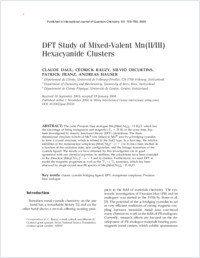DFT study of mixed-valent Mn(II/III) hexacyanide clusters
- Daul, Claude Chemistry Department, University of Fribourg, Switzerland
- Rauzy, Cédrick Chemistry Department, University of Fribourg, Switzerland
- Decurtins, Silvio Department of Chemistry and Biochemistry, University of Bern, Bern, Switzerland
- Franz, Patrick Department of Chemistry and Biochemistry, University of Bern, Bern, Switzerland
- Hauser, Andreas Département de Chimie Physique, Université de Genève, Genève, Switzerland
-
01.11.2004
Published in:
- International Journal of Quantum Chemistry. - 2005, vol. 101, no. 6, p. 753-760
English
The cubic Prussian blue analogue Mn³[Mn(CN)₆]₂·15H₂O, which has the advantage of being transparent and magnetic (TN = 35 K) at the same time, has been investigated by density functional theory (DFT) calculations. The three-dimensional structure is built of MnII ions linked to MnIII ions by μ-bridging cyanides, to form a crystal structure, which is related to the NaCl type. In a first step, the relative stabilities of the mononuclear complexes [Mn(CN)₆]ⁿ⁻ (n = 2 to 4) have been studied as a function of the oxidation state, spin configuration, and the linkage isomerism of the cyanide ligand. The results we have obtained by this investigation are in good agreement with our chemical expertise. In addition, the calculations have been extended to the dinuclear [Mn₂(CN)₁₁]ⁿ⁻ (n = 5 and 6) clusters. Furthermore, we used DFT to model the magnetic properties as well as the 3T1→1T2 transition, which has been observed by single-crystal near-IR spectra of Mn₃[Mn(CN)₆]₂·15H₂O.
- Faculty
- Faculté des sciences et de médecine
- Department
- Département de Chimie
- Language
-
- English
- Classification
- Chemistry
- License
- License undefined
- Identifiers
-
- RERO DOC 4802
- DOI 10.1002/qua.20333
- Persistent URL
- https://folia.unifr.ch/unifr/documents/299769
Statistics
Document views: 85
File downloads:
- 1_daul_dsm.pdf: 206
